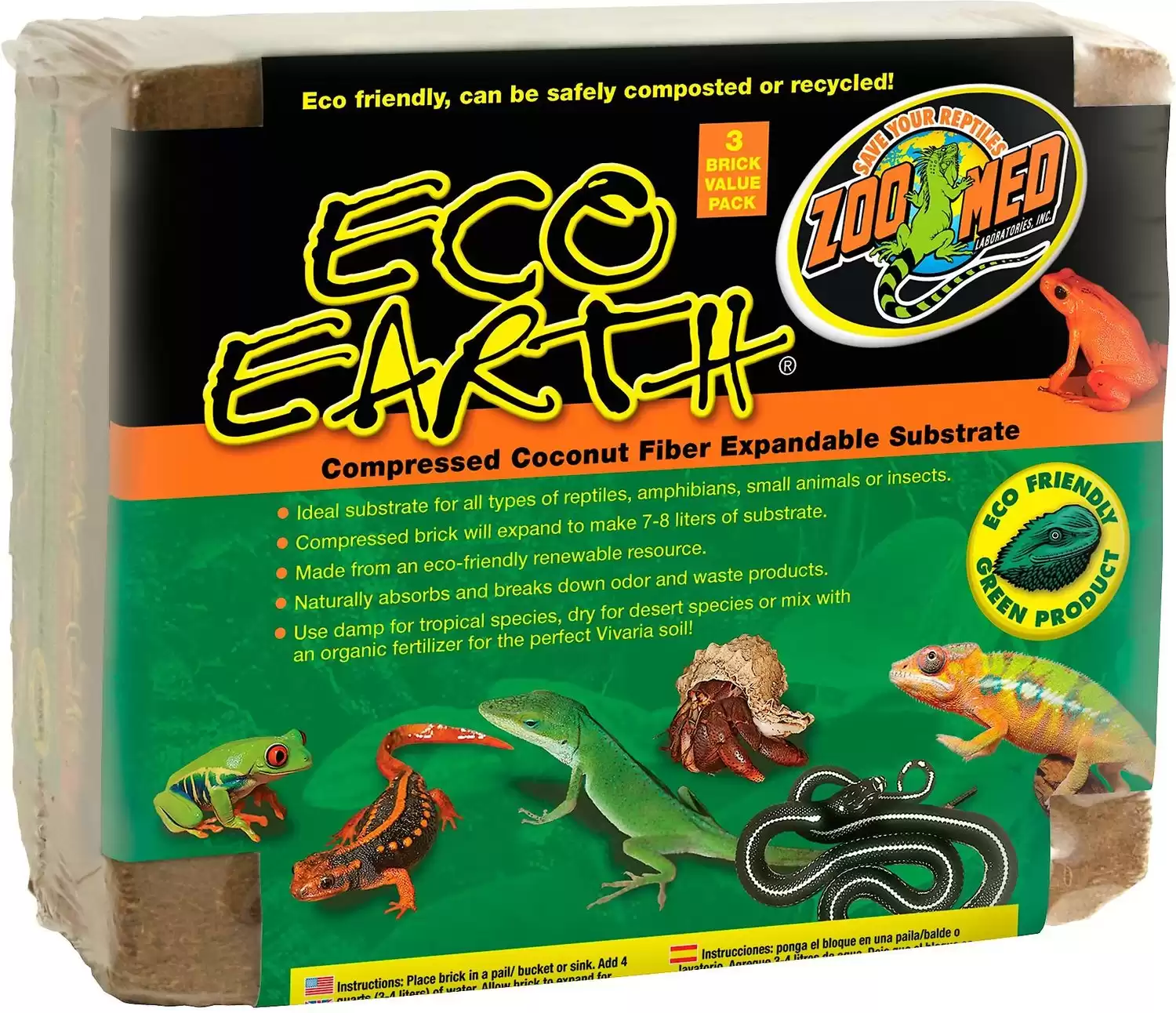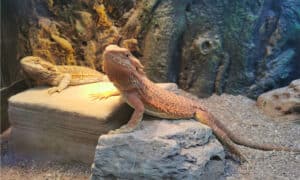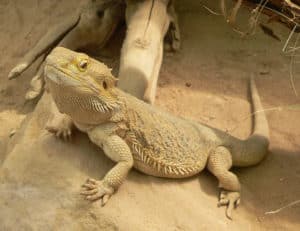| Best for | Product |
|---|---|
| Best Overall | Zoo Med Eco Earth Compressed Coconut Fiber Expandable Reptile Substrate |
| Best on a Budget | Exo Terra Bio Drain Terrarium Draining Reptile Substrate |
| Best for Aesthetics | Zoo Med Eco Carpet |
| Most Natural Substrate | ReptiChip Compressed Coconut Chip Substrate |
Substrates are the material that you use on the floor of your terrarium if you have a pet reptile. This material is important because it can affect the well-being of your pet. Other roles that substrates play in the terrarium include filtration, humidity control, and nesting.
A simple search online will show you multiple materials you can use as substrates for your terrarium. Not all of them are right for your pet, however. You must be careful not to use a substrate that could cause fecal impaction.
Collecting substrates from the wild is also not a great idea for your pet reptile. This is because it could contain harmful chemicals like herbicides and organisms that could damage your pet’s health. Even when you keep your yard clean of these things, poisons can travel through the air and contaminate.
We’ve taken an in-depth look into the substrates you can use for your pet reptile’s terrarium. We list many of them below and provide information to help you choose the one that will work best for your pet. We also share useful links to places you can get great substrates conveniently.
 Check Chewy Check Amazon
Check Chewy Check Amazon- Affordable
- Porous gravel made from lava rock
- Perfect for creating water drainage systems
- Good for filtration and can keep other substrates from contaminating the water
- Most users combine this substrate with sand or moss to create an aesthetically pleasing natural look for their terrarium
 Check Chewy Check Amazon
Check Chewy Check Amazon- No need to worry about your reptile ingesting this substrate
- High-quality green carpet substrate
- Fits a 10-gallon tank snuggly
- Great to try if you're trying to raise the humidity level in your terrarium
 Check Amazon
Check Amazon- Perfect for creating a natural-looking habitat
- Provides superior odor-control
- Helps to maintain the enclosure's humidity level
- Made from eco-friendly coconut husks
- Clean and dirt free
A-Z Animals Top Picks for the Best Substrate for Reptiles
1. Best Overall: Zoo Med Eco Earth Compressed Coconut Fiber Expandable Reptile Substrate
Our selection as the best overall substrate for reptiles is the Zoo Med Eco Earth Compressed Coconut Fiber Expandable Reptile Substrate.
First, you can use this substrate for most reptiles — including geckos, lizards, snakes, bearded dragons. You’ll also love that you get three bricks for an excellent price.
This substrate is made from coconut fiber and looks great in naturalistic setups. It also highly absorbent and breaks down odor and waste products. You can use this substrate dry when making substrate for desert species or dampen it for tropical reptiles to maintain humidity in your terrarium.
You’ll also love that this substrate is eco-friendly. It is a byproduct of the coconut industry and can easily be recycled. Plus, each brick makes seven to eight liters of substrates for your terrarium. However, some customers have reported that the amount produced does sometimes vary between bricks.
Pros and Cons of the Zoo Med Eco Earth Compressed Coconut Fiber Expandable Reptile Substrate
| Pros | Cons |
|---|---|
| This substrate is suitable for most reptiles — including geckos, lizards, snakes, bearded dragons. | The amount of substrate produced by each brick sometimes varies. |
| It is made from coconut fiber. | |
| It is highly absorbent. | |
| Each brick products seven to eight liters of substrate. |
2. Best on a Budget: Exo Terra Bio Drain Terrarium Draining Reptile Substrate
Choosing the perfect substrate for your reptile doesn’t need to break the bank, so that’s why we suggest the Exo Terra Bio Drain Terrarium Draining Reptile Substrate.
This substrate is porous gravel that is perfect when creating a water drainage system in your terrarium for reptiles like lizards and bearded dragons. Plus, this product is natural and does not decompose. This substrate is good for filtration and can also help to prevent your other substrates from contaminating the water.
Unfortunately, it is quite dusty so it is recommended that you rise it before using it.
Pros and Cons of the Exo Terra Bio Drain Terrarium Draining Reptile Substrate
| Pros | Cons |
|---|---|
| This substrate is porous gravel that is ideal for creating a water drainage system. | It is dusty so needs to be rinsed before being used. |
| It is good for filtration and can prevent other substrates from contaminating the water. |
- Affordable
- Porous gravel made from lava rock
- Perfect for creating water drainage systems
- Good for filtration and can keep other substrates from contaminating the water
- Most users combine this substrate with sand or moss to create an aesthetically pleasing natural look for their terrarium
3. Best for Aesthetics: Zoo Med Eco Carpet
For something that is great to look at as well as being a top quality product for your pet we recommend the Zoo Med Eco Carpet.
Zoo Med makes our list again, but this time for a fabulous carpet substrate that reptile owners love. It is made of eco-friendly material from recycled plastic bottles. Plus, you won’t have to worry about your pet eating something they shouldn’t as they cannot ingest this substrate. It is also easy to clean but, if possible, buy two so you can switch them out for washing. It is also inexpensive, which is why most pet parents buy more than one.
The only drawback to this product is that some customers have reported that their geckos sometimes snag their teeth on it as they are eating.
Pros and Cons of the Zoo Med Eco Carpet
| Pros | Cons |
|---|---|
| This carpet substrate is eco-friendly and is made from recycled plastic bottles. | Some customers reported that their geckos snag their teeth on it while they are eating. |
| It cannot be accidentally ingested. | |
| It is easy to clean. |
- No need to worry about your reptile ingesting this substrate
- High-quality green carpet substrate
- Fits a 10-gallon tank snuggly
- Great to try if you're trying to raise the humidity level in your terrarium
4. Most Natural Substrate: ReptiChip Compressed Coconut Chip Substrate
The ReptiChip Compressed Coconut Chip Substrate is the substrate to go for if you want to create a natural and healthy habitat for your reptile.
This substrate comes as a compressed brick and provides 10 pounds of safe bedding for your reptile. It has super odor-absorbing powers to ensure that your pet is always in a clean and healthy environment. It is made from 100% organic coconut chips so you can be certain that it is an eco-friendly option. Plus, it has been cleaned so it creates a dust-free environment for your pet.
Unfortunately, some customers have reported that it is quite dusty and difficult to break open.
Pros and Cons of the ReptiChip Compressed Coconut Chip Substrate
| Pros | Cons |
|---|---|
| This substrate is made from 100% natural coconut chips. | It is difficult to break open. |
| Each brick produces 10 pounds of substrate. | It is dusty. |
| It has odor-absorbing powers so that your reptiles are always in a clean and healthy environment. |
- Perfect for creating a natural-looking habitat
- Provides superior odor-control
- Helps to maintain the enclosure's humidity level
- Made from eco-friendly coconut husks
- Clean and dirt free
Types of Substrates
There are many types of materials that you can use as substrates for your reptile’s habitat. Each comes with features that either make it a plus or not for your pet. Below are some materials that pet owners and even pet stores use as substrates.
Paper Products
These include paper towels, shredded paper, unprinted newspaper paper, and even butcher paper. Paper products are one of the best substrates because they are easy to clean, can be burrowed in, and are inexpensive. Also, with most varieties, you don’t have to worry about them being inhaled. Paper products, however, don’t look very natural, so they might not fit your terrarium’s aesthetic.
Sand
There is always a debate among experts when it comes to using sand as a substrate for your reptile. This is mostly due to the risk of impaction if swallowed, and sand is easy to consume. Some adult reptiles, however, know not to do this, so it can be safe for them.
Most reptiles that eat sand do so on purpose to try to get minerals from it. So, with proper feeding, you could avoid this. Sand as a substrate makes cleaning easy as it clumps around dirt, retains warmth, and makes for good digging.
Sand substrates could either be made of silica or calcium, with many preferring the latter. Experts advise using sand for desert reptile species, and you can also use it in aquatic setups. If using it for aquatic environments, please avoid calcium sands as they can dissolve and change the pH of the water.
Stone
Stone substrates are always a great combination with sand substrates. They help to reduce the risk of sand ingestion and make the habitat look more naturalistic. Stones can also be good heat conductors and are generally used as the bottom layer. However, they can take a considerable amount of time to clean and disinfect.
Wood Products
Wood products like bark are great for maintaining humidity and are often used as sole substrates. You can also mix them with sand substrates. Geckos love them. On the other hand, wood products like shavings can be great for reptiles like snakes and some lizards. They can, however, be hard to clean, and some can be dangerous due to volatile natural oils. Experts recommend kiln-dried aspen shavings. Cedar and pine shavings can contain volatile oils that can irritate your pet’s sensitive respiratory tract, so you should not use them as substrates.
Jungle Substrates
Jungle substrates are great for jungle-dwelling reptiles. One that reptile owners love is coconut fiber. It can retain a lot of water to increase humidity and can be used dry too. This substrate is very resistant to rotting, and burrowing reptiles love it.
Since coconut fiber is a byproduct of the coconut industry, it is extremely inexpensive. It is also considered to be environmentally friendly. Many pet owners use this fiber in combination with bark for their terrarium.
Prepackaged Substrates
Many companies now look into and create substrates with the right nutrients and consistency that your reptile needs. Many of these come as vitamin-rich soils that you can use as bedding in your terrarium. Please ensure that you can use this with your pet without having problems like impaction from feeding on the substrate.
Moss
Moss is great for use as a combined substrate but has a long preparation time. You’ll have to bake it at a high temperature for an hour to ensure it is safe. Most pet owners use it in combination with other substrates to maintain the humidity of their terrarium. It also creates microclimates and pockets where for reptiles like snakes can burrow.
Carpeting
Using artificial carpets like Astroturf for bedding is a great idea. They are easy to clean and look good aesthetically. There is also no risk of ingestion with this substrate as long as you watch out for and remove any loose threads. Carpets are a cheap substrate option and work for any reptile. Experts advise that you keep more than one piece on hand so you can easily switch for cleaning.
The best substrate for your reptile depends on its needs and what you want your terrarium to look like. You should, however, ensure that your option is safe for your pet. Below are some great substrates that you can use and the reptiles you can use them for.
Choosing the Best: What to Look For
Ready to choose the best substrate for your pet reptile? Most of the substrates we choose can be used for reptile terrariums, but the best for your pet depends on some important factors. They are:
- Type of Pet
- Desired Aesthetics
- Price
Here are these factors in more detail:
Type of Pet
The best substrate for your boa constrictor might not be the best for your bearded dragon. So choose a substrate for your reptile based on what works for them. You might also have to select a substrate based on your pet reptile’s age. For example, some adult geckos do fine with a sand substrate, but juvenile geckos could feed on it and become impacted.
Desired Aesthetics
What look do you want your terrarium to have? Some substrates, like the carpet substrate, are aesthetically pleasing and look amazing. You could also use the coconut chip substrate in this list to create a more natural look for your terrarium.
Price
Substrates can be a bit on the expensive side, but there are also some inexpensive options. Our best for affordability in this review has all the features of a good substrate too. Remember that your pet reptile’s health and safety are important when choosing what product to use.
How to Create a Habitat Your Reptile Loves
Building a great habitat for your pet is important if you’re a reptile pet enthusiast. Your pet needs an environment that is healthy and stimulating to stay happy. Here are some tips to keep in mind as you create the perfect habitat.
- Consider the natural environment: What does the natural habitat of your pet reptile look like? This will help you build an environment that your pet loves. For example, a pet snake will enjoy spending the day lounging on substrate, while a pet lizard needs rocks to climb and stay active.
- Stable environment: So, do lots of research for specific requirements and when you get it, do your best to maintain it. Having a stable environment is important for the health of your pet reptile. Things like humidity and lighting will play a huge role.
- Use the right measurements: Don’t forget to include tail length when taking measurements for your pet’s habitat. Your pet reptile could also reach impressive dimensions as an adult. When possible, add an inch or two extra to the size enclosure you’ve selected
- Decorate: Use logs, plants, rocks, and trees to decorate your terrarium whenever possible. Choose a great-looking substrate too. Reptiles love to have places to play and hide. You could also go with a design theme like “tropical island.”
Other Materials You Can Use as a Substrate
You can also use materials like soil or even litter as substrates for your pet reptile. You should, however, ensure that this is safe and that your pet will not get injured or poisoned with these options.
Substrates to Avoid
The kind of substrate to avoid will depend on your pet reptile species. Most experts, however, have a problem with sand substrates because they come with a risk of impaction. Moss substrates could also grow a mold that could be dangerous to your health.
| Best for | Product |
|---|---|
| Best Overall | Zoo Med Eco Earth Compressed Coconut Fiber Expandable Reptile Substrate |
| Best on a Budget | Exo Terra Bio Drain Terrarium Draining Reptile Substrate |
| Best for Aesthetics | Zoo Med Eco Carpet |
| Most Natural Substrate | ReptiChip Compressed Coconut Chip Substrate |
How to Choose the Best Substrate for Your Reptile’s Terrarium FAQs (Frequently Asked Questions)
What can I use as a substrate for a lizard?
This review contains a list of some of the best substrates you can use for lizards and where to buy them. Carpet, coconut fiber, and gravel can be good substrates for your pet lizard.
What substrate is not safe for reptiles?
Generally, sharp rocks are not good for use as substrates for reptiles. There are also other options that are more personal to the kind of reptile that you have. We discuss this and more in the review above.
What do you put in the bottom of a reptile tank?
Substrates like sand, gravel, carpet, moss, and even newspapers make for great reptile tank bottoms. You could also use coconut fibers or soil as your reptile tank substrates.
Thank you for reading! Have some feedback for us? Contact the AZ Animals editorial team.





